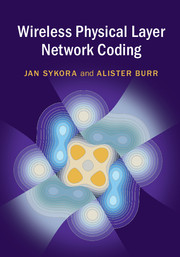Book contents
- Frontmatter
- Contents
- Preface
- Mathematical Symbols
- Abbreviations
- Part I Motivation and Gentle Introduction
- Part II Fundamental Principles of WPNC
- 3 Fundamental Principles and System Model
- 4 Components of WPNC
- 5 WPNC in Cloud Communications
- Part III Design of Source, Relay, and Destination Strategies
- Appendix A Background Theory and Selected Fundamentals
- References
- Index
5 - WPNC in Cloud Communications
from Part II - Fundamental Principles of WPNC
Published online by Cambridge University Press: 01 February 2018
- Frontmatter
- Contents
- Preface
- Mathematical Symbols
- Abbreviations
- Part I Motivation and Gentle Introduction
- Part II Fundamental Principles of WPNC
- 3 Fundamental Principles and System Model
- 4 Components of WPNC
- 5 WPNC in Cloud Communications
- Part III Design of Source, Relay, and Destination Strategies
- Appendix A Background Theory and Selected Fundamentals
- References
- Index
Summary
Introduction
This chapter focusses on a global whole-network perspective of WPNC networks. It is in contrast with Chapter 4, which rather focussed on individual building blocks and a local neighborhood of the node. The WPNC network is a cloud network that serves its outer terminals/nodes (sources and destinations) with a communication service that does not necessarily need to reveal all its internals to the terminal nodes, hence the name WPNC cloud.
The quality of the WPNC cloud service has two basic aspects: (1) delivering the desired information to the given destination node, and (2) quantitative performance aspects of this delivery. Both aspects have to respect various network constraints and design decisions, e.g. half-duplex constraint, relay node strategies, channel parametrization, etc. From a practical perspective, we usually prefer to build a complex WPNC cloud from the smaller building blocks sharing some common relay strategy. Following the hierarchical principle, the smallest building blocks are the ones given by a node interacting with its direct local radio neighborhood as described in Chapter 4.
We first show how to build the cloud hierarchically from the local components while making sure that the desired information from the sources makes its path to its destination. Second, we focus on the overall end-to-end performance metric and information-theoretic limits. This will include information-theoretic general bounds and also a performance assessment of some particular encoding strategies, namely Noisy Network Coding, Compute and Forward, and Hierarchical Decode and Forward of Layered NCM. Finally, we analyze conditions of end-to-end solvability of HNC maps including the H-processing operation aspects.
Hierarchical Structure and Stages of Wireless Cloud
Hierarchical Network Transfer Function
Let us assume that the building blocks of the WPNC cloud are half-duplex constrained relays performing their front-end strategy (multiple-stage H-MAC), back-end strategy (H-BC), and the relay processing strategy described by the HNC map χ and the associated information measure μ(x) (see Chapter 3). We assume that we are also given a connectivity map of the network. The goal is to develop a technique that will allow us to find the whole encapsulation hierarchy of the information flow between the source and its target destination respecting all involved HNC maps, Tx activity stages, received signals participating in a given HNC map, mixed-stage flows, and potential buffering at nodes.
- Type
- Chapter
- Information
- Wireless Physical Layer Network Coding , pp. 112 - 190Publisher: Cambridge University PressPrint publication year: 2018



